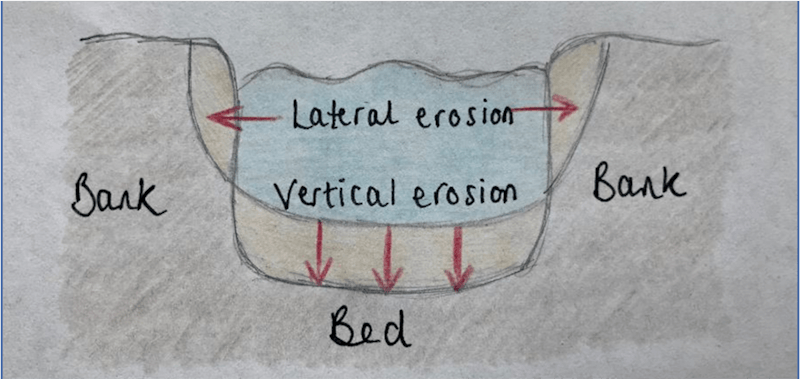Study Notes
GCSE Geography | Erosion, Transportation and Deposition (River Landscapes 1)
- Level:
- GCSE
- Board:
- AQA, Edexcel, OCR, Eduqas
Last updated 24 Apr 2024
The processes of erosion, transportation and deposition play a huge role in shaping river valleys.
Erosion
This is the wearing away of rock. There are 4 specific processes that you need to know:
- Hydraulic action - this is the sheer force of fast-flowing water hits the river banks and bed and forces water into cracks. This compresses air in the cracks, and weakens the rock. It causes vertical erosion in the upper course, and lateral erosion in the middle course, especially when fast-flowing water hits the outside bend of a meander – leading to meander migration
- Abrasion - this is where small boulders and stones being transported by the river may scratch and scrape the river banks and bed. Stones which have recently fallen into the river have angular, sharp, jagged edges; and are particularly good for abrasion. Ongoing abrasion is responsible for both vertical erosion and lateral erosion (see below)
- Attrition - this is where stones being carried along by the river will collide with each other, and the river banks and bed. As they do this their jagged edges will be knocked off or smoothed down. Some stones may smash into several smaller ones, which will be eroded further into smooth pebbles.
- Solution - this is where carbon dioxide in the atmosphere dissolves in the river to form a weak acid. As the water flows through the channel it will react with the rocks in the river banks and bed. This chemical reaction will cause the rocks in the river bank and bed to dissolve, particularly chalk and limestone
River valleys experience both vertical and lateral erosion...
- Vertical erosion - this is downwards erosion that makes the river bed deeper. It is usually caused by hydraulic action and occurs in the upper course of the river, causing steep-sided v-shaped valleys
- Lateral erosion - this is sideways erosion, wearing the river bank away to make the channel much wider. It occurs in the middle and lower courses of the river and leads to wide flat valleys

Transportation
Fluvial transportation is the process by which a river carries its load. Load differs in size, from large, angular boulders in the upper course, to fine, suspended silt in the lower course. Load comes mainly from material that has weathered and tumbled down the hillside, though some comes from eroded river banks. There are 4 specific processes of transportation that you need to know:
- Traction - near the source of the mouth the bedload is quite large and heavy as it hasn’t been eroded that much at this point - so large boulders and rocks are rolled along the river bed as they are too heavy to move in any other way. We find this type of transportation in the upper course of the river
- Saltation - in the upper course we also find saltation – this is where small pebbles and stones are bounced along the river bed (see the diagram below). They are bounced along as they get lifted and dropped with the rise and fall of the water’s velocity
As we move further down the river into the middle and lower courses of the river the material being transported is much smaller as it has been eroded more
- Suspension - this is fine light material, also known as silt, that’s carried with the river’s flow (suspended load). This is what often makes the river look really dirty, when it isn’t. Particles carried in suspension will settle at the bottom if kept in a jar of water, and the water will look clean
- Solution - this is where minerals are dissolved in the water and tiny invisible particles are transported by the river (not to be confused by the erosional process of solution!)

Deposition
This is the river dropping its transported load. The bigger the particles being transported the greater the velocity that is needed to keep the load moving, so once the river starts to lose energy the largest boulders are the first to be dropped onto the river bed. This is why you see large boulders in the river bed in the upper course of the river, close to the source, but fine silt in the lower course, closer to the mouth of the river.
You might also like

A River Forms - Time Lapse
18th February 2015
River profiles
Study Notes
Coastal Systems - Features of Coastal Erosion
Study Notes
Coastal Features and Coastal Landscapes
Study Notes